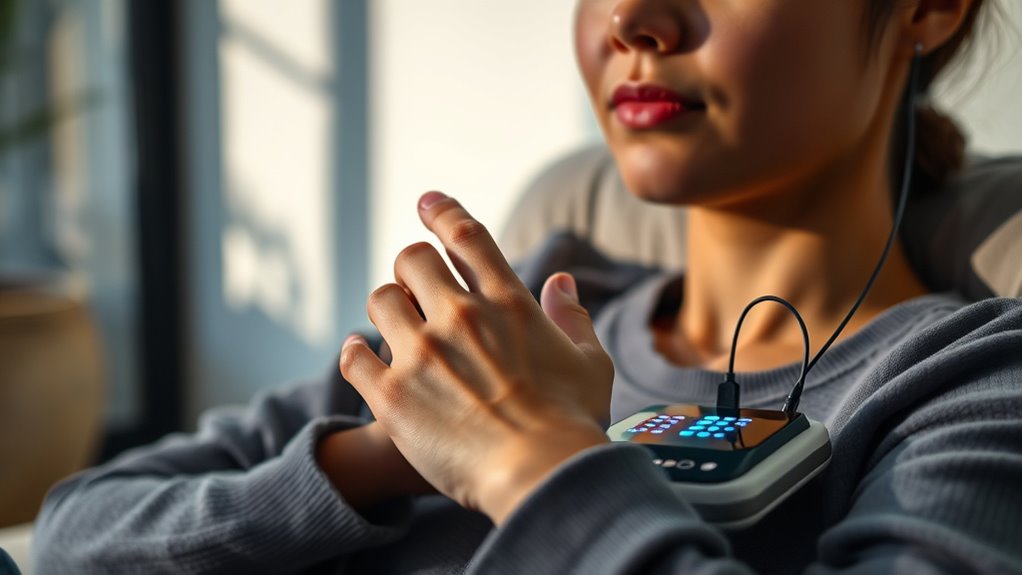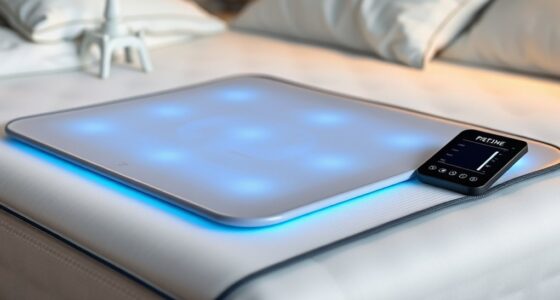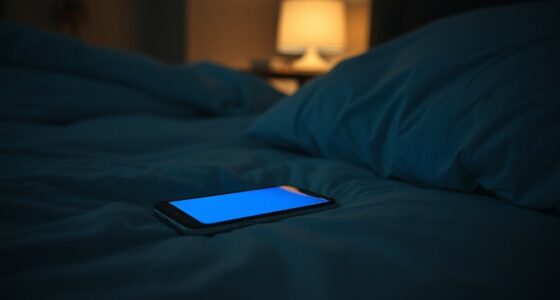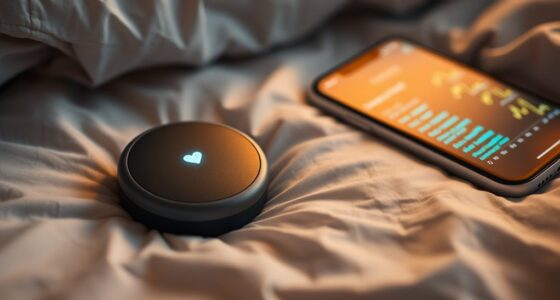Biofeedback devices help you actively recognize and control your body’s stress responses by providing real-time data on heart rate, muscle tension, and breathing. This instant feedback makes you more aware of how stress impacts you and guides you to relax through techniques like deep breathing or muscle relaxation. Over time, this practice boosts your sense of control and mastery, leading to lasting relaxation. Keep exploring to discover how these tools can transform your stress management skills.
Key Takeaways
- Provide real-time physiological data to increase awareness of bodily responses to stress.
- Offer visual or auditory cues that guide users toward relaxation during mindfulness practices.
- Enable conscious adjustment of relaxation techniques based on immediate feedback of bodily responses.
- Foster a sense of control by demonstrating tangible progress in managing stress responses.
- Support long-term stress reduction by helping users develop personalized, effective relaxation habits.

Biofeedback devices have become popular tools for enhancing relaxation by helping you gain awareness and control over your body’s physiological responses. When you use these devices, you can see real-time data about your heart rate, muscle tension, skin temperature, or breathing patterns. This immediate feedback allows you to understand how your body reacts to stress and helps you develop effective stress management techniques. By practicing with biofeedback, you learn to regulate your body’s responses, reducing tension and promoting a calmer state of mind.
Biofeedback devices help you understand and control your body’s stress responses for better relaxation.
One way biofeedback supports relaxation is by integrating with mindfulness meditation practices. As you focus on your breath or bodily sensations, the device provides visual or auditory cues that confirm you’re in a relaxed state or guide you back if you start to tense up. This feedback loop deepens your mindfulness meditation, making it more effective at calming your mind and body. Over time, you begin to recognize early signs of stress and can intentionally activate relaxation responses before stress escalates. This proactive approach strengthens your ability to manage daily stressors more effectively.
Biofeedback also helps you explore various stress management techniques with precision. For example, if you notice your heart rate spikes during a challenging task, you can consciously slow your breathing or relax your muscles. Watching how your physiological responses change in real time reinforces your understanding of what relaxation strategies work best for you. It’s like having a personal coach guiding you through relaxation exercises, ensuring you’re applying them correctly and effectively. This immediate validation boosts your confidence and encourages consistent practice.
Furthermore, biofeedback devices foster a sense of control, which is essential for reducing anxiety. When you see tangible evidence that your efforts to relax are working, it reinforces positive habits. This sense of mastery can diminish feelings of helplessness often associated with stress and anxiety. As you regularly practice, you develop a more intuitive connection between your mental state and physical responses, making it easier to implement relaxation techniques whenever you need them.
In essence, biofeedback devices empower you to take an active role in your relaxation journey. They complement mindfulness meditation and other stress management techniques by providing the data you need to understand and refine your approach. With consistent use, you can cultivate a calmer, more centered state of mind, even amid life’s inevitable stresses. This combination of awareness, control, and practice leads to lasting improvements in your overall well-being and resilience. Additionally, understanding the financial impact of wellness tools like biofeedback devices can motivate continued investment in your mental health.
Frequently Asked Questions
Can Biofeedback Devices Replace Traditional Stress Management Techniques?
You might wonder if biofeedback devices can replace traditional stress management techniques. While they offer real-time insights and help you practice mindfulness integration, they shouldn’t fully replace practices like a digital detox or deep breathing exercises. Instead, use biofeedback as a complementary tool to enhance your overall stress management plan. Combining technology with mindful habits creates a balanced approach, making relaxation more effective and sustainable.
Are Biofeedback Devices Effective for Children or Adolescents?
You might wonder if biofeedback devices work for children or adolescents. They can be quite effective, especially with child-friendly applications designed to engage young users. These devices help with adolescent stress management by teaching relaxation techniques through real-time feedback. When used consistently, they empower your child to recognize stress signals and develop healthier coping skills, making them a valuable addition to traditional methods.
How Long Does It Typically Take to See Benefits From Biofeedback Training?
Imagine a journey where each step brings you closer to calm. The duration expectations for seeing benefits from biofeedback training vary, often spanning several sessions. You might notice improvements within a few weeks, but individual variability plays a big role. Some experience rapid results, while others need more time. Stay patient, as consistent practice can release relaxation, making the wait worthwhile and guiding you toward a more peaceful state.
Are There Any Risks or Side Effects Associated With Biofeedback Devices?
You might wonder if biofeedback devices have risks. While generally safe, there are potential device malfunctions that could affect accuracy or cause minor discomfort. Also, since these devices collect user data, privacy concerns are valid if data isn’t properly protected. However, choosing reputable brands and following instructions can minimize risks. Overall, with proper use, side effects are rare, and benefits often outweigh potential concerns.
What Factors Influence the Accuracy of Biofeedback Measurements?
Your biofeedback device’s accuracy hinges on several factors. Sensor calibration is vital; if it’s off, measurements can be wildly inaccurate, like trying to read a map in a storm. Environmental interference, such as electrical noise or movement, can also distort readings. To guarantee precise results, keep sensors properly calibrated and minimize external disruptions. This way, your device provides reliable data, guiding you towards true relaxation and wellness.
Conclusion
As you hold a biofeedback device in your hand, notice how it transforms your stress into calm, like a storm settling into still waters. Instead of chaos, you create clarity; instead of tension, find tranquility. These devices turn your body’s signals into a gentle guide, helping you relax amidst the chaos of daily life. With each session, you’ll discover how technology can be a quiet ally, transforming tension into peace, and chaos into calm.









